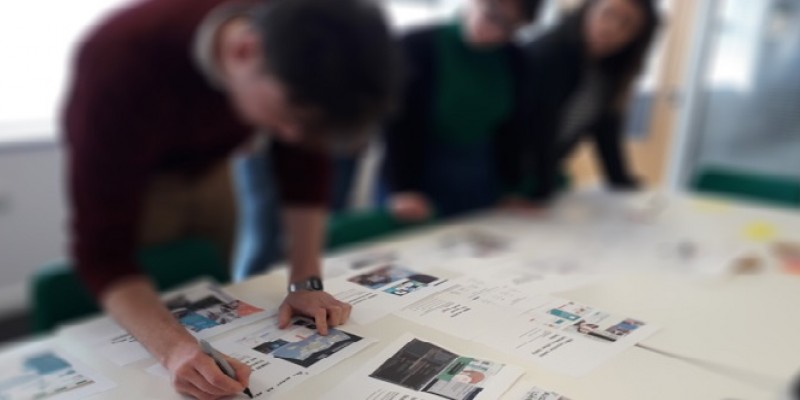
Design Thinking helps businesses to create user-centric products and services by discovering insights into user needs, applying these insights to their business model and generating innovative ideas.
In this five-part series, Business West’s design innovation specialist, Sarah Dickins, gives advice on product innovation and how to use Design Thinking tools to develop innovative products.
In part three Sarah looks at the ‘Interpretation’ phase, which is the phase after 'Discovery' as detailed in the image below.
The Interpretation Phase
The 'Interpretation' phase is essential for taking an innovative rather than reactive approach to product development. 'Interpretation' helps to ensure proactive - ahead of the trend - decision making by extracting meaningful insights from user feedback, rather than implementing it directly.
Case Study Example:
"As one of our most rapidly-growing clients, I was intrigued to meet the team at Helm Tickets, an award-winning ticketing software company based in Plymouth.
As we delved into their NPD processes, it became apparent that much of Helm’s success originates from a commitment to intelligently implementing user feedback then rapidly developing new user-centric features using Agile methodology. But every approach has its limitations.
The feedback loop had made the team highly responsive, but the team were aware that feedback was often limited by a user’s former experience i.e. usually users would request something that was similar to something they had experienced previously with a competitor platform.
Rather than react and differentiate from competitors, the Interpretation phase would be valuable to Helm to be able to innovate and scale while remaining user centric.
How can the Interpretation phase help a business?
The purpose of the interpretation phase is to convert information into inspiration. It can help a business to:-
- Apply innovative thinking for ahead-of-the-game development
- Ensure better differentiation from competitors
- Enable development of scalable user-centric services
We dig deep into the observations from the 'Discovery' phase to find patterns and insights. These are then reformatted to help the whole team to digest them rapidly at the beginning of an 'Interpretation' session.
Soon, after the research sessions are complete, a team work together to map out the key findings. To help to get a good understanding of the audience and context, tools such as 'personas', 'a day in the life' and 'journey of interaction' are good ways to start.
Then, post-it notes can be used to map out key insights. Finally, those key insights can be framed as opportunities by rewording them as questions - to provoke creative thinking - using the ‘How Might We?’ format (covered below.) Content from David Kelly, IDEO, [International Design & Consulting firm]
Content from David Kelly, IDEO, [International Design & Consulting firm]
Beware of shortcuts
The 'Discovery' process helps to gather information about user and context. It is best to wait until after the 'Discovery' session to interpret observations to inspire new ideas. The challenge is that it is tempting to try to shortcut to interpretation mode while conducting the research, which leads to making assumptions. It takes real discipline and belief in the process to dogmatically leave interpretation until after the sessions have taken place.
'How might we’s'
The purpose of reframing insights as ‘How Might We’ questions is to help translate an insight into something that can fuel creative thinking.
Take a food delivery company, for example:
Insight: Office workers in outlying areas are frustrated by the limited choice of food for lunch, but perceive deliveries to be too expensive to be an option.
- How might we make multiple orders simple and attractive to cross sell to peers?
- How might we enable a local vendor to offer a better range of food?
- How might we enable people to experience the range on offer?
- How might we lower the cost to individual workers in outlying areas?
- How might we appeal to all office workers, while tailoring to individual preferences?
There are several ‘How might we’ statements which would yield creative solutions to the problem and we would choose the most promising of these to fuel the Ideation session.
Keep the end in sight
The end goal of the Interpretation phase is to convert information into inspiration for the Ideation (ideas) session which follows, so the atmosphere and the content needs to feel inspiring rather than dry.
Great visual communication is vital and it is worth spending some time to determine how best to present the content. Use images, low quantity of text and large type to bring the insights to life. As with every workshop, the outcome is often heavily influenced by the environment, so where possible, it is best to move tables and chairs out of the way and to pin visuals up onto the walls.
The Interpretation phase is essential for taking an innovative rather than reactive approach to product development. Interpretation tools help to extract insights from user feedback to inspire innovative new ideas, rather than implementing the feedback directly. The beauty of the Interpretation phase is that it actually takes a relatively short period of time to implement and can enable you to gain much greater value from your research.
The next phase of the Design Thinking process is Ideation.
Read part four of this series to help you to generate high quality, commercial ideas for products and features.
About the author
Sarah Dickins, Business West’s design innovation specialist, has over the past five years worked with established R&D teams in companies such as Sony Electronics, Unilever and Walgreens Boots Alliance, helping them to innovate and create new products.
More in the series:
Read Part 1: Design Thinking for Business Success: Design Thinking for Innovation
Read Part 2: Why you should begin every project with Discovery: Design Thinking
Read Part 4: How to have great ideas: Design Thinking for Innovation
Read Part 5: How to fail fast: Design Thinking for Innovation
- Log in to post comments
